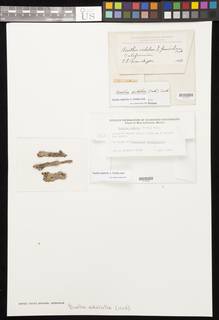
Consortium of Lichen Herbaria
- building a Global Consortium of Bryophytes and Lichens as keystones of cryptobiotic communities -
- Home
- Search
- Images
- Species Checklists
- US States: O-Z >
- US National Parks
- Central America
- South America
- US National Parks
- Southern Subpolar Region
|
|
|
|
Family: Caliciaceae
|
Nash, T.H., Ryan, B.D., Gries, C., Bungartz, F., (eds.) 2007. Lichen Flora of the Greater Sonoran Desert Region. Vol 3. Thallus: crustose, thin and rimose-areolate to thick and rugose-verrucose or even subsquamulose; prothallus: black surface: yellowish white to glaucous gray, smooth, esorediate medulla: white, often with calcium oxalate (H2SO4+ needle shaped crystals) Apothecia: lecideine, abundant, 0.2-1.6 mm in diam., sessile disc: black, often pruinose, with white pruina consisting of calcium oxalate crystals, initially flat, soon convex margin: black, initially distinct, later excluded, enclosing disc in young apothecia proper exciple: 35-95 µm thick, lacking secondary metabolites; not clearly differentiated into separate parts, dark brown throughout with carbonized cells (<6 µm, HNO3-), transient with the brown, 180-230 µm thick hypothecium (HNO3-) epihymenium: brown, pigmentation continuous with the outer exciple (HNO3-) hymenium: hyaline, inspersed with numerous oil droplets, 95-120 µm tall; tips of paraphyses: usually <3 µm wide with distinct apical caps asci: clavate, Bacidia-type, 60-95 x 17-29 µm, 8-spored ascospores: soon brown, submuriform, mature spores with 6-12 cells in optical section, ellipsoid to narrowly ellipsoid, (17-)22.8-[25.7]-28.6(-35) x (9.5-)11-[12.4]-13.8(-16) µm, with lateral and septal wall thickenings (conspicuous at early stages of the spore ontogeny), proper wall: c. 0.9 µm thick, perispore c. 0.2 µm thick, ornamentation: not visible in DIC Pycnidia: often present, c. 0.2 x c. 0.15 mm, immersed, flask-shaped, sometimes secondarily compartmentalized; wall pigmented in upper part conidia: bacilliform, 5-6 x c. 1 µm Spot tests: thallus K-, C+ orange (best seen under the microscope), P-; medulla K-, C-, P- fluorescence: UV+ bright or pale yellow to orange iodine reaction: medulla non-amyloid Secondary metabolites: diploicin (major), isofulgidin (minor), and a xanthones of unknown structure, related to 7-chloronorlichexanthone (minor). Substrate and ecology: on bark and wood of branches and twigs of shrubs and trees in the coastal deserts World and Sonoran distribution: coastal fog zones of Baja California and Baja California Sur south of the 29th parallel. Notes: Buellia oidaliella is characterized by its Buellia oidalea-like thallus morphology and the conspicuous spore wall thickenings (Nordin 1999, Figs. 11 and 12). It differs from B. oidalea by having distinctly smaller spores with thin-walled apices, a hymenium that is less tall, and calcium oxalate forming a thin pruina on the thallus surface and the apothecial discs. |
Powered by Symbiota

















